Options strategies refer to methodical combinations of buying or selling call and put options to structure trades with defined risk-reward profiles. Option strategies provide flexibility for traders to express opinions on market direction, volatility, time decay and other factors. Popular strategies include spreads, straddles, condors and butterflies.
Options strategies utilize the asymmetrical and time-sensitive payoff profiles of call and put options to create advantageous trade structures. For example, bull call spreads offer defined-risk long exposure. Bear put spreads provide short exposure with capped downside. Strategies blend options to shape desired positives like lower cost, reduced risk or higher probability.
Mastering essential strategies like long calls, long puts, covered calls, and cash-secured puts establishes core knowledge. These basic structures demonstrate foundational concepts like directional exposure, volatility sensitivity, time decay impact and profit potential. They illustrate options, behaviour and mechanics.
1.Long Call
The long call is one of the most basic and versatile options trading strategies. Long call involves buying call option contracts to benefit from an upside move in the underlying stock. Long calls offer leveraged profits with limited risk. Here is a detailed overview of how long calls work and how to implement them.
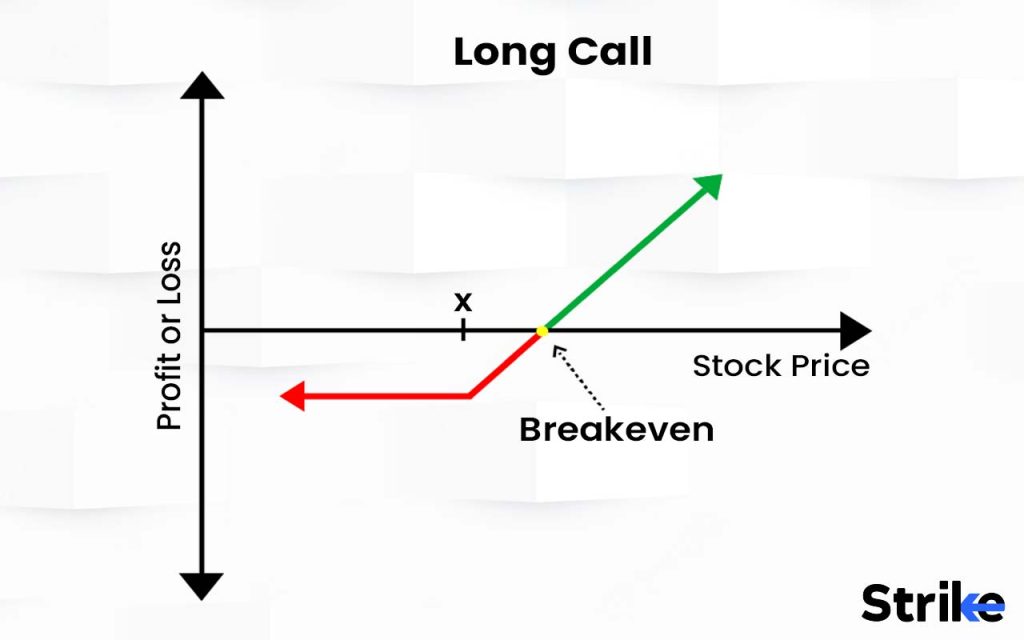
A long call position is created when an options trader buys call option contracts on an underlying stock. Each call option contract gives the buyer the right, but not the obligation, to purchase 100 shares of the underlying stock at the specified strike price on or before the call expiration date.
The long call strategy aims to profit from the anticipated upside in the stock’s price. For the call buyer, the maximum loss is limited to the Premium paid to buy the calls. The potential profit is unlimited as the underlying stock price rises infinitely.
Long call positions are typically initiated when the trader expects the underlying stock to experience a significant price rally during the life of the options. This upside price move allows the purchased call options to increase in value.
Stock ABC is trading at Rs.50 per share
Trader buys 10 contracts of the ABC 50 call expiring in 2 months at Rs.2 premium
Consider ABC stock rallies to Rs.60 at expiration, then the calls will be worth at least their Rs.10 intrinsic value. The trade has Rs.10 x 1000 = Rs.10,000 of potential profit against Rs.2000 risked.
Instead, ABC rises to Rs.53 with a month left, and then the calls trade for Rs.3.50 due to the remaining time value. The trader sells the calls and captures Rs.1500 profit.
Long calls have the following risk-reward profile. Risk is limited to the Premium paid-to-buy-the-call options. The entire Premium is lost if the calls expire worthless. The reward is unlimited upside if the underlying stock rises. Each point increase equals intrinsic value gains.
Break-even stock price = Strike price + Premium amount
To profit, the stock must move above the break-even level by expiration. The higher the price rise, the greater the potential returns due to leveraged exposure.
2. Short (Naked) Call
Selling uncovered or naked call options is an income-generating options strategy with major risks if the underlying stock rises sharply. Naked calls involve substantial leverage and unlimited loss potential. Traders use them to collect premiums but need robust risk management.
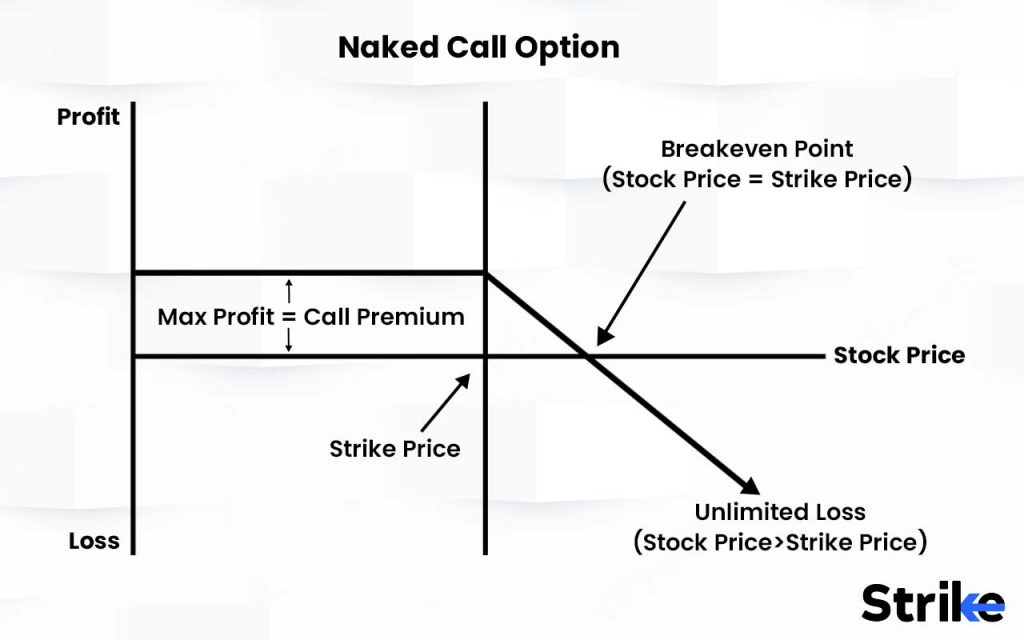
A short naked call position involves selling call options without owning the underlying stock or any offsetting long calls. The call writer collects the Premium as profit but is exposed to unlimited loss if the stock rallies above the short call strike.
Each naked call sold represents an obligation to sell 100 shares of the stock at the strike price through expiration. Assigned on the calls, the trader must buy the shares at market price to cover – even if much higher than the strike.
Traders sell naked calls when they expect the stock to stay neutral or decline during the life of the options. The stock remains below the call strike at expiration, which means the calls expire worthless, and the writer keeps the full Premium—the strategy profits from time value decay.
However, the stock rises significantly, signifying deep losses accrue for the naked call writer due to being short the calls without any hedge or risk coverage. Buying back the appreciating short calls at a loss becomes necessary to manage the position.
Risk is Unlimited if the stock rises. Losses grow exponentially as stock exceeds strike. Margin requirements are high. Reward is limited to the Premium collected from short call sales. The maximum reward is the credit received.
Break-even = Strike price + Premium received
The downside break-even point is the strike plus premium amount. Above this stock price at expiration, losses accrue rapidly.
Naked call writing generates income but carries substantial risk. Strict risk mitigation, like stop-loss orders, is essential. Traders should be highly experienced before selling uncovered calls due to the leverage involved.
3. Long Put
Long puts are created when a trader buys put option contracts on an underlying stock. The long put option represents the right, but not the obligation, to sell 100 shares of the stock at the specified strike price at any time through the expiration date.
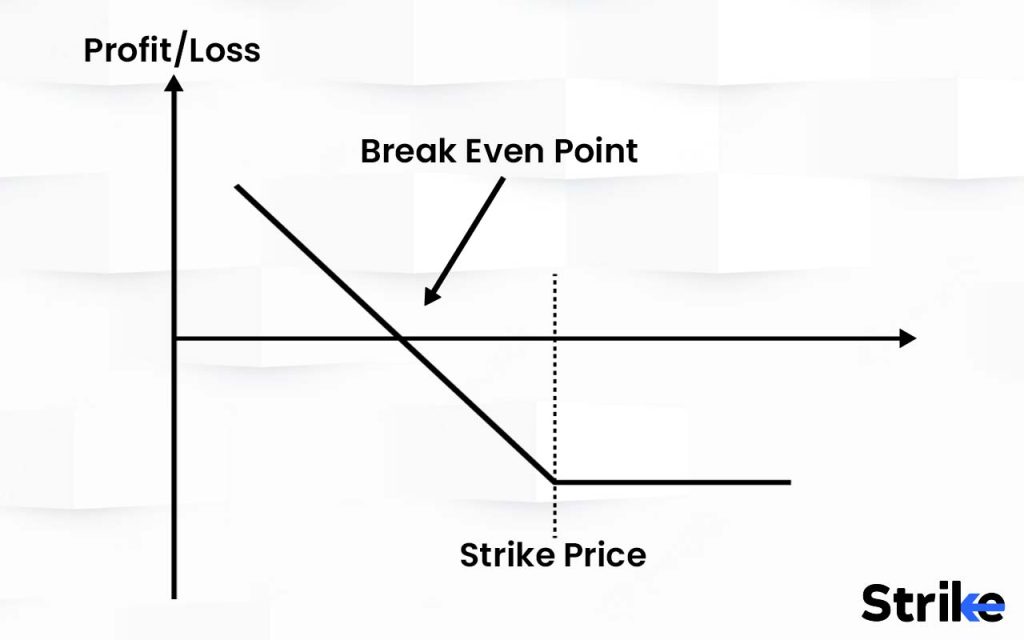
The goal is to benefit from the anticipated downside in the stock by purchasing puts. The maximum risk on long puts is limited to the Premium paid to buy the options.
Long puts are used when the options trader forecasts the stock will experience a bearish price move during the life of the options. As the stock drops below the put strike price, the put options gain intrinsic value.
There are two approaches to profit from long puts. The stock drops below the put strike, so the puts are exercised to capture intrinsic value, or the puts rise in premium value without exercise due to increased implied volatility. The trader sells the puts back to the market at a higher price.
In both cases, long put holders are able to benefit from the declining stock price either through realized or unrealized gains.
Risk is limited to the Premium paid to purchase the put options. The entire Premium could sometimes be lost. Reward is unlimited upside if the underlying stock price falls. Gains grow as the stock drops below strike.
Break-even = Strike price – Premium amount
The stock must fall below the break-even point to generate a profit by expiration. The greater the decline, the higher the potential returns.
4. Short (Naked) Put
A short naked put position is created when a trader sells put options without being short the underlying stock. The short naked put writer collects the Premium as profit but faces potentially unlimited losses in a downside stock move.
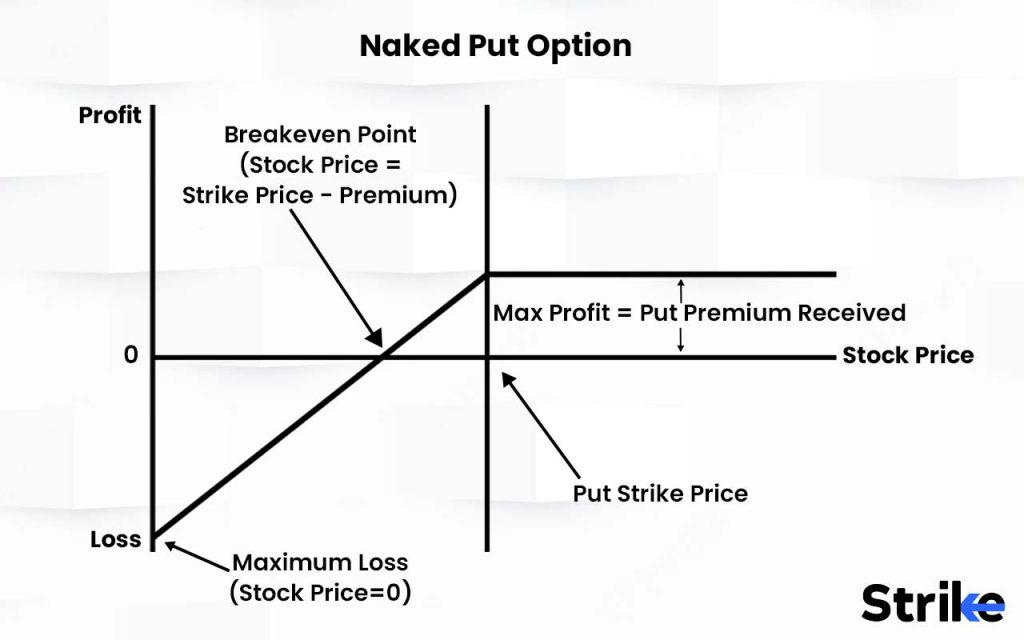
Cash must be set aside to buy the stock if assigned on the short puts. Each naked put sold represents an obligation to purchase 100 shares at the strike price through expiration if exercised.
Traders sell naked puts as a cash-secured strategy when they expect the stock to remain neutral or rise during the life of options. If the stock stays above the put strike at expiration, the short puts expire worthless, allowing the seller to keep the full Premium.
However, substantial losses result if the stock price declines below the strike. The assignment becomes likely, requiring the put writer to buy the shares at the higher strike price. To exit, they must buy back the appreciating puts at a loss. Consider this hypothetical naked put trade.
It has unlimited downside if the stock price falls sharply. Losses accelerate below the strike price. Reward is limited to the premium income received from the short-put sales.
Break-even = Strike price – Premium amount
The strategy’s break-even point is the strike minus the Premium. Below this stock price at expiration, growing losses occur.
What Do Option Strategies Mean?
Option strategies refer to different ways investors use option contracts to try to profit from anticipated moves in the underlying security. IOption strategies like spreads, straddles, and collars are used to speculate on upside or downside moves, generate income, and hedge risk.
A call option gives the holder the right to buy the underlying asset at the strike price on or before the expiration date. Buying calls is a bullish strategy used when you expect the price of the underlying to rise. Some examples of basic call option strategies are below.
Long Calls mean buying call options. You profit if the underlying price rises above the strike price by an amount greater than the Premium paid.
Covered Calls considering you already own the underlying asset, you will be able to sell call options against that position. If the options are exercised, you get to sell your shares at the strike price. The premium income reduces your effective cost basis. It caps your upside if the stock rises but generates income.
A put option gives the holder the right to sell the underlying asset at the strike price on or before expiration. Buying puts is a bearish strategy used when you expect prices to fall. Examples include the below.
Long Puts means buying put options. You profit if the underlying falls below the strike price by more than the Premium paid.
Protective Puts mean considering you own the underlying asset, buying puts protects against downside risk. It’s like insurance if the stock falls. The put Premium is the cost of that insurance.
Spreads involve the simultaneous buying and selling of two or more options with different strike prices or expirations. Spreads limit potential upside but also reduce the net Premium paid.
As you gain experience, you employ more advanced strategies. The key is to start simple, use defined risk trades, and get an understanding of how options work before progressing to more complex approaches. A few basic strategies executed well give you a solid footing in options trading.
How Do Option Strategies Work?
Options strategies work by utilizing different combinations of option contracts to take advantage of expected movements in the underlying security. Investors can use strategies to speculate on the upside or downside, generate recurring income through premiums, and offset risks in a portfolio.
For example, a bull call spread works by buying call options at one strike price while selling the same number of calls at a higher strike to reduce costs but still profit if the underlying rises. Bear put spreads work in the opposite way to profit from a fall in the underlying.
Strategies allow tailored positions to match an investor’s market outlook and risk appetite. The many combinations offer flexibility but require an understanding of options greeks and careful management for desired results.
How to know which Option strategy Should be Used?
Investors choose which strategy should be used based on their market outlook, risk appetite, and investment goals. First, they need to determine if they have a directional bias, like expecting an upside or downside move. This informs strategies like call/put buying or vertical spreads.
Next is deciding if they want exposure just to price movements or volatility. Strategies using straddles and strangles incorporate volatility views. Time horizon also matters since longer-dated options have higher time value.
Investors also need to evaluate how much risk they are able to take, like capping upside/downside versus uncapped potential. Level of capital commitment is also key as some strategies require more outlay than others. Expected return prospects need to align with return objectives, too. Strategies used to generate income, like covered calls, have lower return potential versus speculative plays like long calls. Tax considerations are also important for taxable accounts.
Sound risk management through appropriate strategy selection, position sizing, diversification, and defined exit plans is crucial. Investors should backtest strategies using historical scenarios to assess viability. Ongoing monitoring is key as market conditions change. The array of strategies allows great flexibility, but the appropriate match requires research, active management, defined risk parameters, and disciplined execution.
What is the Importance of the Basic Options Strategies?
Understanding basic options strategies is important for traders who want to use options effectively in their overall trading plans. Options offer unique advantages that stocks alone cannot provide, but you need knowledge of options basics and strategies to utilize them properly. Here are seven of the key reasons why options strategy understanding is so important.
Options provide leverage since they allow you to control large numbers of shares for a small upfront premium. This gives options traders the ability to get greater upside exposure for less capital outlay compared to just buying or shorting stock directly. Strategies like long calls or long puts allow leveraged directional bets with fixed, defined risks. Even spread trades provide leveraged exposure for lower net costs compared to owning the equivalent number of shares. Utilizing options appropriately magnifies gains.
Options give you tools to hedge risks in ways that stock alone cannot. Strategies like covered calls and protective puts let you generate income or limit the downside on existing share positions. Knowing how to use spreads allows you to define risk levels precisely. With proper strategy understanding, options help manage and reduce overall portfolio risk.
Options have an expiring time value component that gradually decays over the life of the contract. Many options strategies are structured to benefit from time decay. Income trades like short vertical spreads, iron condors, and covered calls extract profit as the short option loses time value. Strategies that benefit from theta decay produce income even in sideways markets.
Options are used to construct trades with well-defined risks that profit from a stock moving up, down, or sideways. With the variety of strategies available, there is an approach to match any market outlook or scenario. This versatility is invaluable in allowing you to generate returns consistently, regardless of broader market conditions.
Options prices are highly sensitive to expected volatility. Certain strategies are structured to make money from increases or decreases in volatility. Long straddles and strangles benefit when volatility expands. Short straddles and iron condors profit when volatility declines. Knowing how to trade volatility through advanced strategies leads to big returns.
Owning protective puts or using collars are examples of strategies that limit downside risk. They are used to hedge a portfolio from market crashes or protect against losses on an individual stock position. Defined risk spreads also cap the maximum loss. Strategies utilizing options properly help guard against catastrophic losses.
Options allow you to structure intelligent trades around events like earnings, FDA decisions, mergers, etc. Strategies like straddles and strangles are ideal for profiting from binary events. You will able to tailor option trades to take advantage of short-term opportunities that arise.
What are the Advantages of Options Strategies for Trading?
Options offer unique strategic advantages that make them powerful trading vehicles. This list outlines 5 of the key benefits options provide compared to just buying stock alone. After reviewing these compelling reasons to trade options, you will understand why learning basic options strategies is so important.
1. Leverage
Options provide leverage because they allow you to control 100 shares of the underlying stock for just the price of the option premium. This gives them greater profit potential with less capital outlay compared to buying the stock outright. For example, instead of buying 100 shares for Rs.50 per share and tying up Rs.5,000, you could buy 1 call option contract with an Rs.50 strike price for just Rs.500. The options contract controls the same 100 shares and still provides unlimited upside if the stock price rises.
2. Defined and Limited Risk
Many options strategies like call/put spreads have defined maximum risks. No matter how far the underlying stock moves against the trade, you know the most you may lose is the Premium paid for the options. This is unlike trading stocks, where short positions have unlimited risk if the stock rises. Defined risk allows better money management.
3. Ability to Profit from Time Decay
Options have a time value that decays over the life of the contract. Strategies like covered calls, cash-secured puts, and credit spreads allow you to profit as time value decays. You make money even if the stock doesn’t move. Time decay benefits options sellers.
4. Directional and Non-Directional Strategies
Options allow you to trade strategies that profit from specific directional moves, volatility expansion, or no move at all. You will be able to tailor strategies to match any market thesis or outlook using calls, puts, spreads, straddles, etc. Versatility to trade any market conditions is a major advantage of options.
5. Hedging and Protection
Options provide portfolio protection because they allow you to hedge risks on existing investments. Protective puts and collars limit potential downside on stock positions you own. Credit spreads cap losses. Options permit flexibility in managing risks.
Compared to just trading stock, options strategies offer greater leverage, defined risk, time decay benefits, versatility, and hedging that make them advantageous trading vehicles. But you must understand the basics before utilizing them.
What are the Disadvantages of Options Strategies for Trading?
While options offer many strategic advantages, they also come with some potential disadvantages to consider. This list highlights 5 of the key disadvantages to be aware of when utilizing options in your overall trading plan. However, being mindful of these challenges and using options properly helps overcome them.
1. Time Decay Hurts
Time decay, or theta, sometimes works against options buyers. As options approach expiration, the time value component decays, hurting long calls and puts. You need the underlying stock to move quickly and favourably to overcome time decay. Strategies like spreads reduce but don’t eliminate time decay risk.
2. Complexity and Education Needed
Options have more moving parts and complexity than simple stock trades. You must understand how options are priced, time to expiration impacts, strike selection, and combining legs before employing strategies. There is a learning curve to use options appropriately. Rushing in without knowledge sometimes leads to costly mistakes.
3. Bid-Ask Spreads Impact Costs
Options markets tend to be less liquid than stocks, which leads to wider bid-ask spreads. This impacts the price of entering and exiting trades. Larger spreads increase costs and hurt overall profit potential on trades. Illiquid options should generally be avoided.
4. Access to Quality Trading Tools is Needed
To effectively trade options, you need access to quality options analysis and screening tools. This includes options pricing calculators, volatility analysis, strategy profit/loss simulation, and screening for liquid options. With the right tools, Precise strategy implementation is easier.
5. Options Do Not Always Hedge Effectively
Although options hedge stock positions, they don’t always provide perfect protection. Factors like the timing of market moves, improper strategy selection, and volatility changes affect hedging effectiveness. Options still require active management as a hedge.
While very useful, options do have some inherent drawbacks versus stock trading. Their complexity, education required, time decay element, liquidity challenges, and cost factors should be considered. Maintaining realistic expectations and applying options appropriately mitigate these disadvantages.
What are the Different Levels of Options Trading?
Options offer strategic tools usable by traders of all experience levels. But like any skill, it takes time to master the intricacies of options trading. This guide outlines the major levels of options knowledge, starting from basic call and put buying all the way up to advanced implied volatility and portfolio strategies. Progressing through each stage systematically is key to fully utilizing options in your overall trading plan.
Level 1: Buying Calls and Puts
The most basic level of options trading involves simply buying a call and put options. At this stage, you are using options in their most basic form to speculate on directional moves higher or lower in the underlying stock. No multi-leg strategies are utilized. The main concepts to learn are call/put basics, strike selection, and time to expiration differences.
Level 2: Covered Calls and Protective Puts
The next step is learning how options hedge and generate income on existing stock positions. Popular strategies are covered calls against long stock to collect Premiums and protective puts to limit downside risk. Key concepts include how options work symbiotically with stock holdings.
Level 3: Vertical Spreads
After understanding long calls and puts, spreads like bull call spreads, bear put spreads, and credit spreads allow you to define risk precisely. It spreads cap upside but also limits potential losses. Spread construction, margin requirements, and risk graphs are important to grasp.
Level 4: Diagonal Spreads
Diagonal spreads, like calendar spreads, take advantage of options expiring at different times. The key is understanding how time decay differences between near-term and longer-dated options produce trading opportunities. Volume and liquidity considerations are critical when using diagonal spreads.
Level 5: Combination Strategies
At this level, you begin combining multiple options on the same underlying stock to form more complex strategies. These include straddles, strangles, butterflies, condors, collars, and other multi-leg approaches. Interaction between options legs and risk management is key.
Level 6: Portfolio Strategies
Here, you implement options strategies in the context of overall portfolio management. Examples are hedging existing stock positions, generating consistent income via options overlay strategies, and actively managing risk/return profiles. Requires broad options knowledge.
Level 7: Volatility Trading
Advanced options traders will focus heavily on implied and statistical volatility. Spread construction specifically aims to profit from volatility expansion, contraction, skew, or term structure. Involves advanced Greeks and pricing dynamics.
Options offer tools usable by traders of all experience levels. However, progressing up the learning curve in orderly steps is critical to utilize options properly at each stage.
How To Start Trading Using Options Strategies?
Traders start using option strategies by developing a solid understanding of options mechanics and risks. This includes how options are priced based on intrinsic and time value as well as sensitivity to the Greeks. Traders should then identify their market outlook and objectives, whether it is directional bets, income generation, or portfolio insurance. This shapes strategy selections like long calls/puts for speculative views or credit spreads for defined risk.
Proper position sizing is critical, so traders should determine appropriate allocations for each trade and overall portfolio based on account size and risk tolerance. It’s better to start small to evaluate strategy effectiveness. Traders need to identify advantageous entry and exit points through technical and volatility analysis. Disciplined trade management as per a trading plan is key, like taking quick profits or cutting losses short before they accumulate.
Continuous learning and review of strategy outcomes are essential to refine the approach and risk-reward ratios. Traders should maintain detailed records of rational performance and modify strategies as required. Patience and discipline are vital as options trading requires specialized knowledge. Following a systematic process allows traders to leverage options strategies effectively with contained risk.
When Do the Options Trade During the day?
Options, during the day, trade on exchanges with specific trading hours set. The major options exchanges like CBOE and NYSE have normal trading hours from 9:30 AM to 4 PM Eastern Time. This coincides with regular stock market hours, allowing sync between options and their underlying securities. Options cannot be traded outside of these hours.
However, the ability to trade differs within the trading session based on the type of options. Index options that have ETFs as proxies, like S&P 500 options, can be traded throughout market hours just like ETFs. Equity options trading is more restricted and follows rules based on the underlying stock’s listing venue.
For stocks listed on the NYSE and NASDAQ, options can trade starting from 9:30 AM and have flexibility until 4 PM close. But stocks listed on other smaller exchanges cannot have their options traded during the first 10 minutes from 9:30 to 9:40 AM and the last 10 minutes from 3:50 PM to 4:00 PM. These restrictions aim to align equity option trades with periods when underlying stocks are actually changing hands.
Where Do the Options Trading happen?
Options trade on regulated exchanges, which provide centralized liquidity, clearing, and settlement. The major exchanges for options trading are below.
The largest options exchange, CBOE, offers options trading on thousands of equities, ETFs and indexes. It pioneered listed options in 1973 and remains the premier exchange for equity options and volatility products like the VIX. CBOE is well-known for its robust liquidity, competitive fees, and innovative product development.
Through NYSE American and NYSE Arca, the NYSE lists options on over 2,000 underlying securities, including stocks, ETFs, and indexes. NYSE Arca specifically focuses on options tied to ETFs. NYSE provides deep liquidity pools for active options traders.
NOM offers trading in options on stocks, ETFs, indexes and futures across diverse sectors like tech and biotech. Over 1,000 underlying securities have listed options at NOM. It utilizes the Nasdaq trading system and integrates well with Nasdaq equity trading activities.
Bats focuses on providing low-cost options trading solutions with transparent fee structures, streaming quotes, and high throughput order matching. It connects active traders directly to options liquidity pools using a modern market structure.
MIAX is a fully electronic options trading exchange that offers options on equities, ETFs and indexes. It aims to leverage technology to provide high-speed, efficient trade execution in listed options. MIAX competes on speed, fees, and tools for active traders.
The exchanges compete by offering extensive product listings, robust trading technology, competitive fees, and innovative offerings. Trading options on the major exchanges provide transparency, liquidity, and regulatory oversight. The concentrated liquidity results in tight bid-ask spreads and efficient order execution. These advantages make the major exchanges ideal venues for active options traders.
Can Options be Traded for Free?
Yes, it is possible to trade options for free or at a very low cost at many online brokers these days. Use brokers offering commission-free options trading. These brokers introduced zero-commission options trading several years ago.
Look for promotional deals from brokers that offer hundreds of commission-free trades for new accounts. Use a broker like Interactive Brokers that offers discounted options trades for high-volume traders.
Are the Options Strategies Risky for Trading?
Yes. The largest risk when buying options is that the options expire worthless, and you lose 100% of the Premium paid. This happens if the underlying stock fails to move favourably before expiration. The risk is known and limited to the amount paid upfront, but losing the entire Premium is still possible each time you buy calls or puts.
Selling/writing naked call options carries unlimited downside if the stock rises rapidly above the strike price. The potential loss if the stock rallies higher is uncapped. This is because you are short the call without an offsetting long position in the underlying. Only very experienced traders should consider naked call writing.
Are Options for Trading Very Complex but Rewarding?
Yes, options trading does involve more complexity than simple stock trading, given the many variable factors at play. Multiple expiration dates, the ability to buy or sell options, various strike prices, and fluctuating volatility all impact pricing and strategy outcomes.
There are also four options “Greeks” to understand (delta, gamma, theta, vega). This diversity of inputs means options demand deeper knowledge before trading compared to stocks.
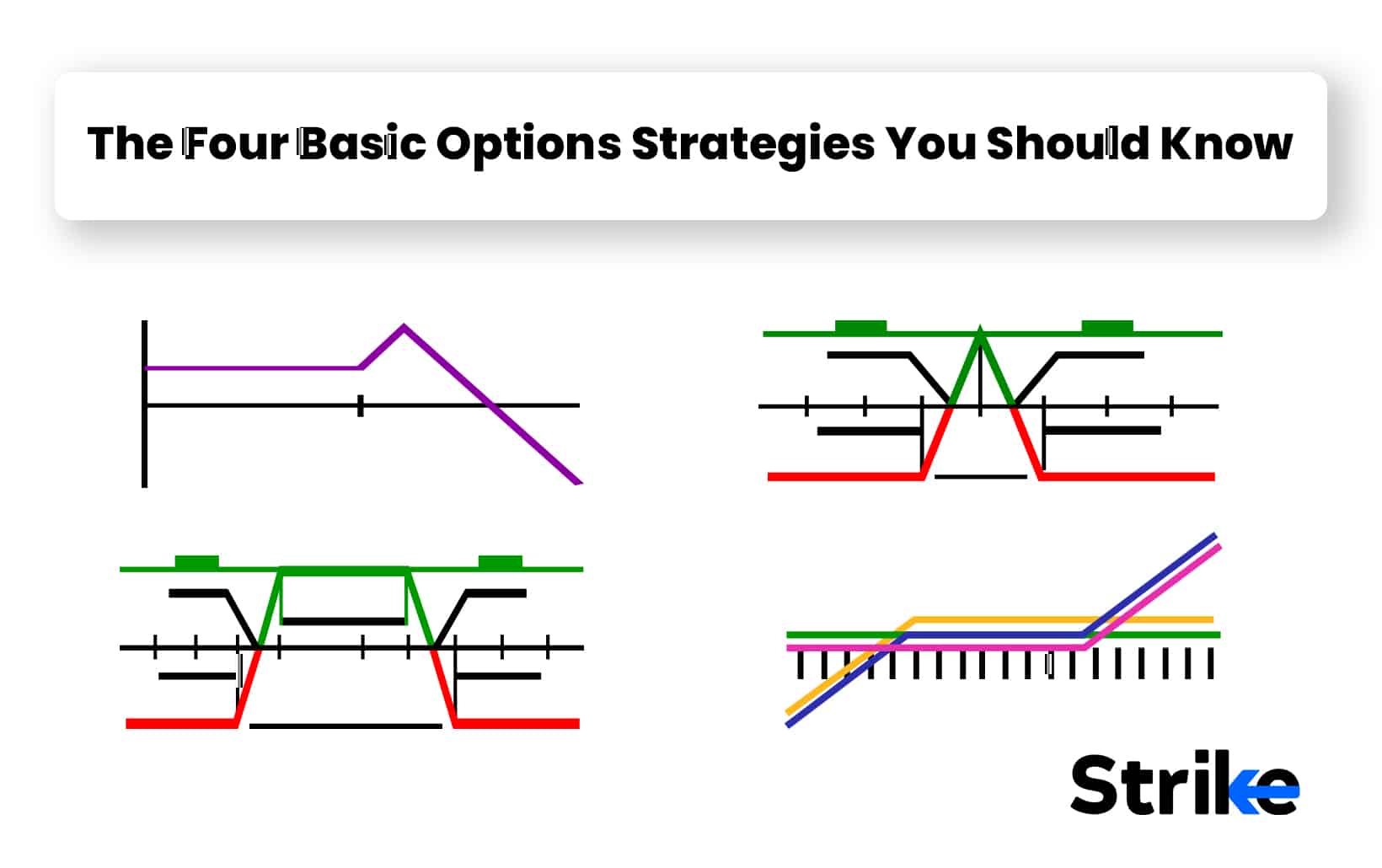





 Previous Article
Previous Article






No Comments Yet